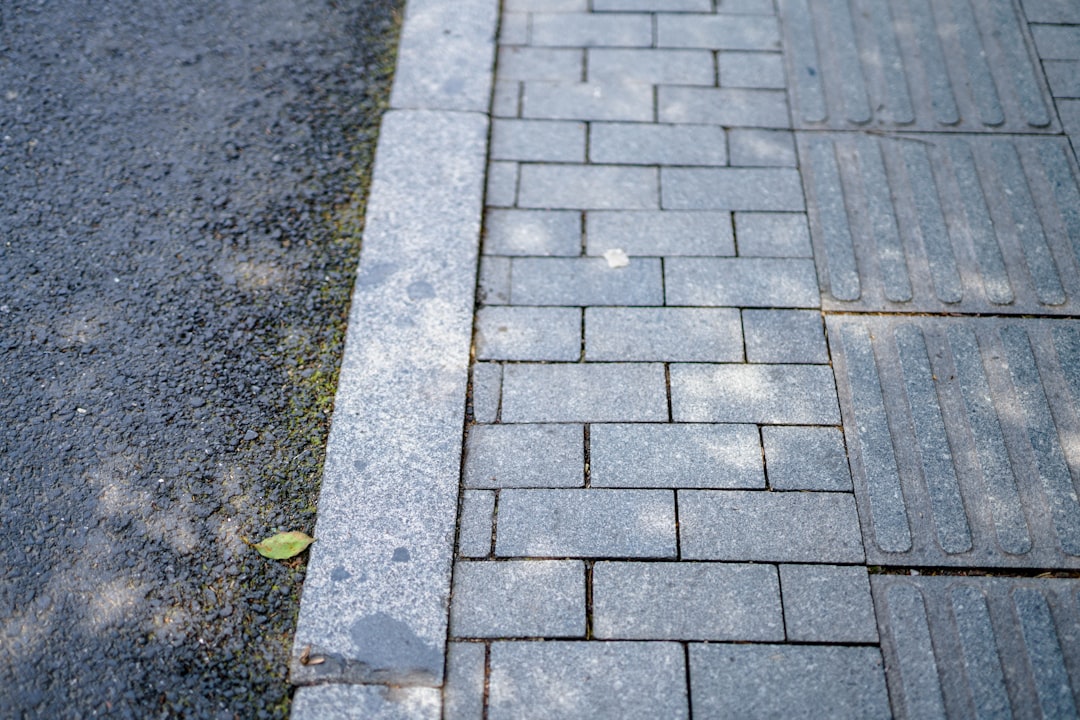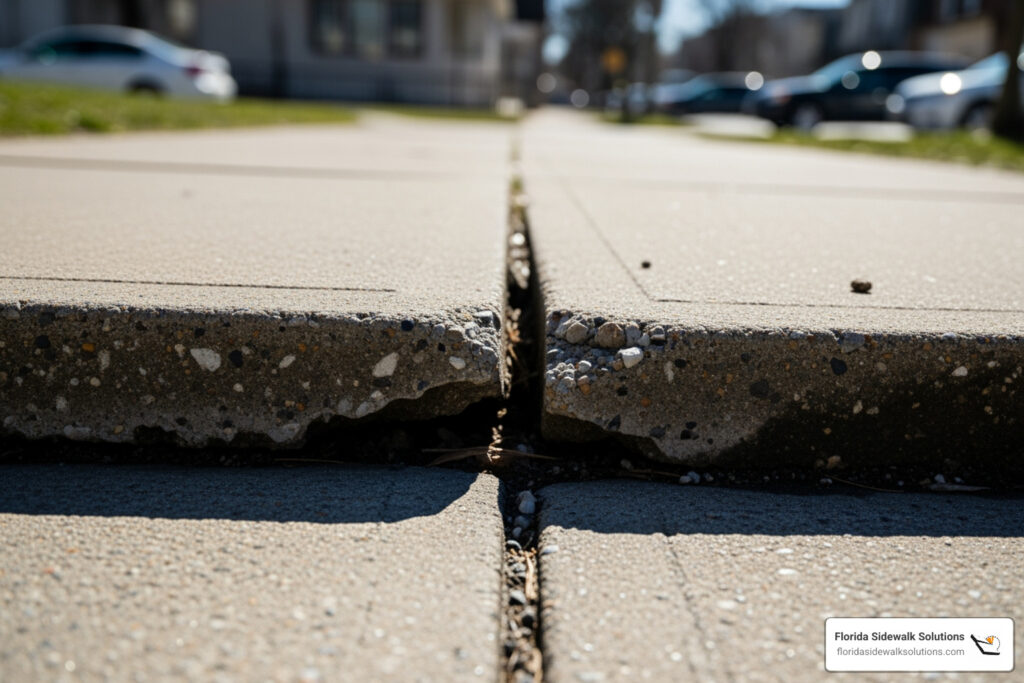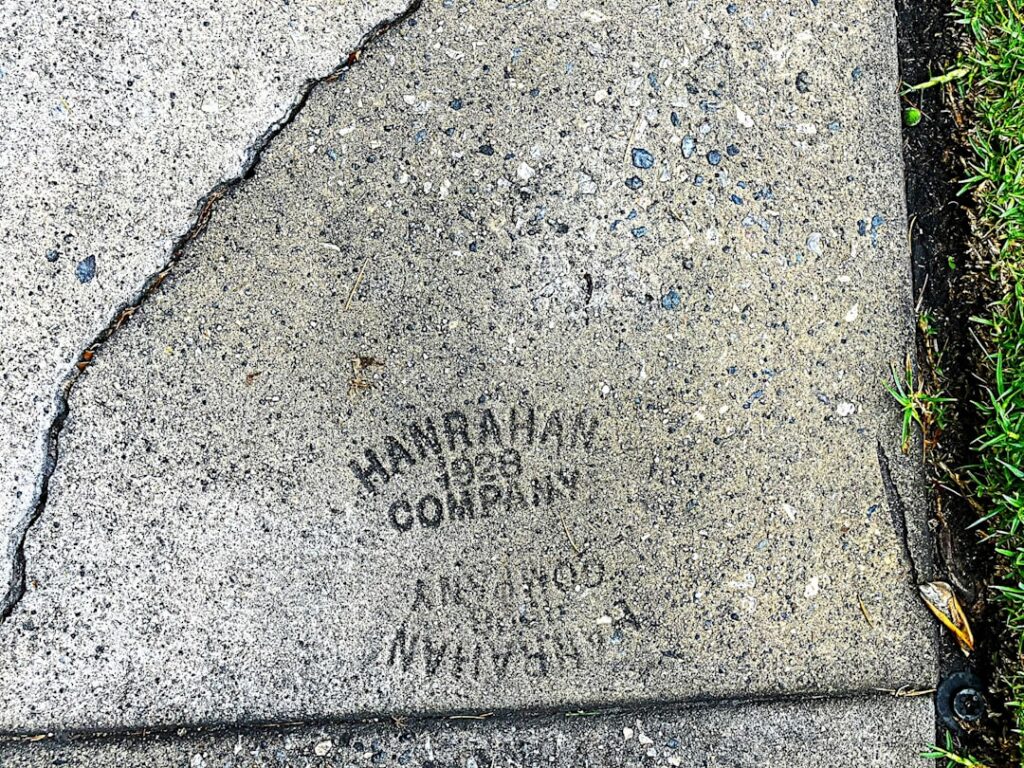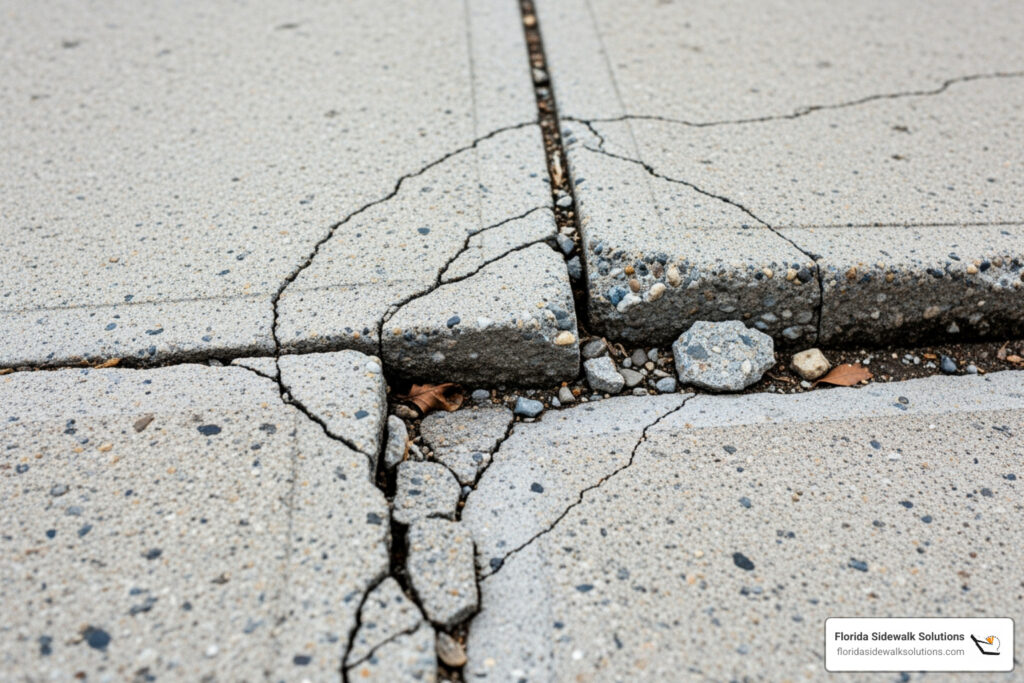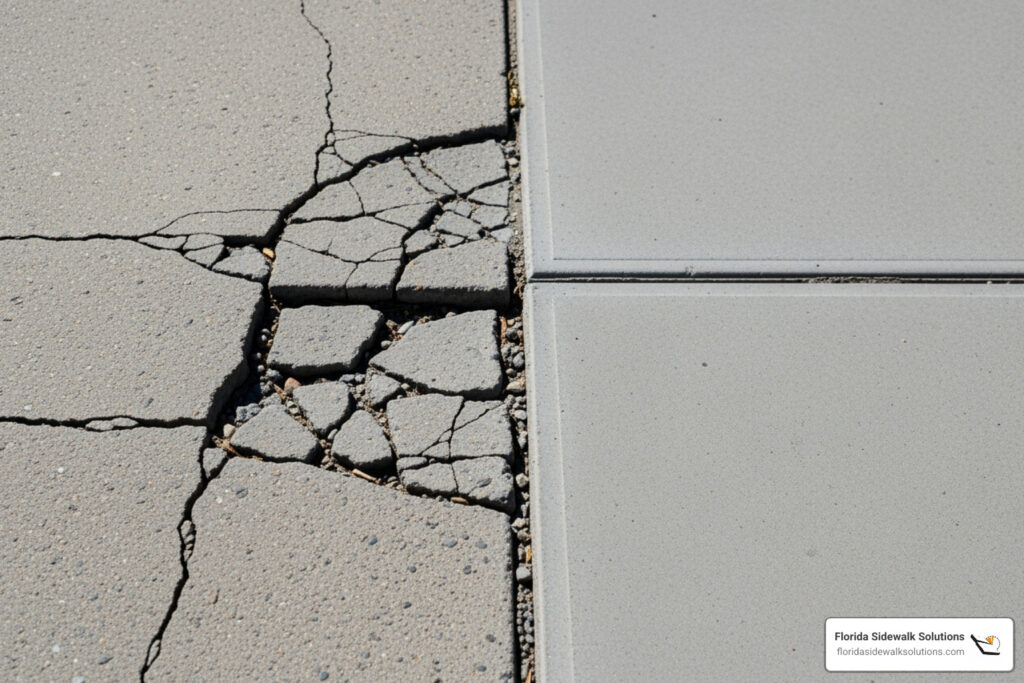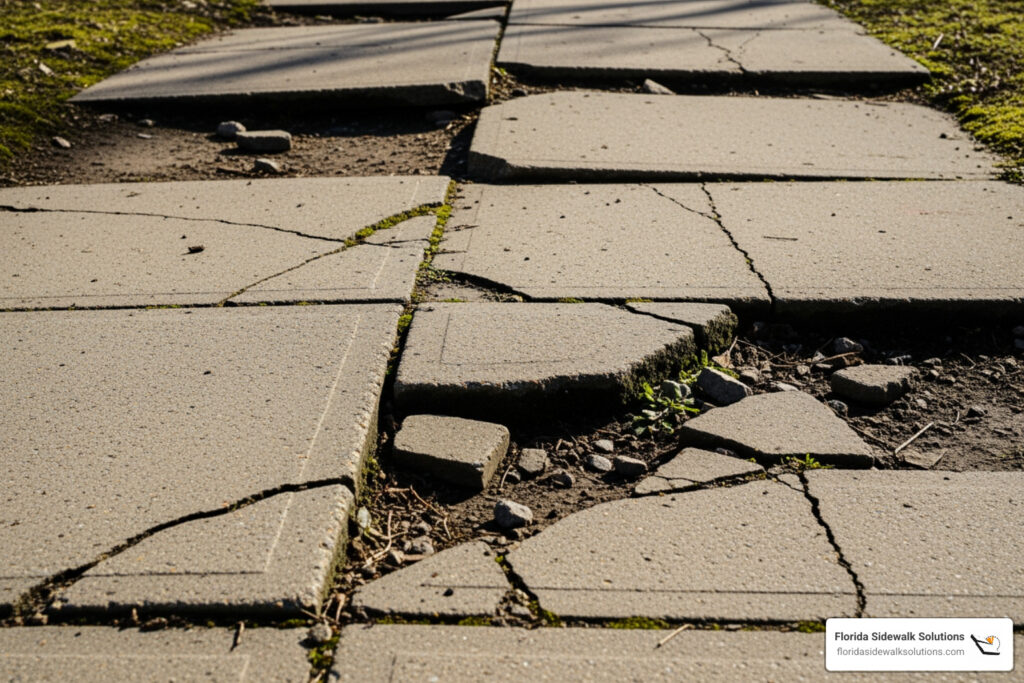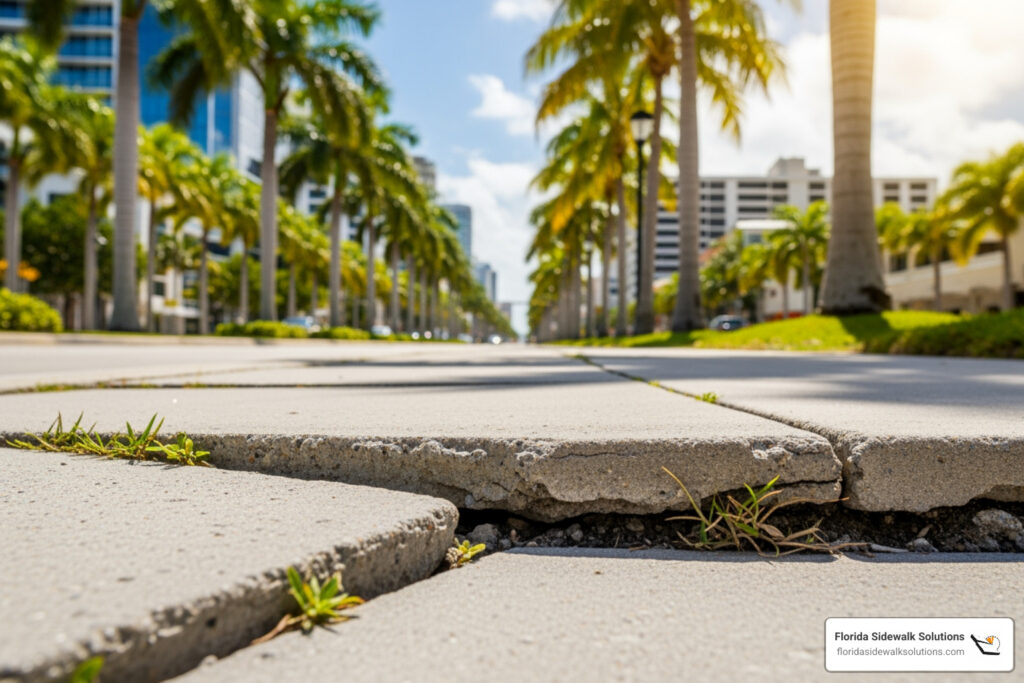Who’s on the Hook? Understanding HOA Sidewalk Repair Responsibility
HOA sidewalk repair responsibility typically depends on three key factors:
- Location: Sidewalks adjacent to private property are usually the homeowner’s responsibility, while walkways in common areas (pools, clubhouses, shared green spaces) fall under HOA jurisdiction.
- Governing Documents: Your community’s CC&Rs and bylaws define specific maintenance obligations that may differ from standard arrangements.
- Local Ordinances: Municipal codes often require adjacent property owners to maintain public sidewalks, even if they’re technically in the city’s right-of-way.
Just like other parts of the community, HOA sidewalks need regular maintenance and repair. But when a crack appears or a panel lifts, who actually fixes it?
This question trips up many homeowners and board members. In most communities, the answer isn’t simple. California Streets and Highways Code sections 5610-5629 place sidewalk maintenance responsibility on property owners, even for sidewalks in the city right-of-way. Yet HOAs are typically responsible for common areas. And in some cities, the municipality handles certain repairs.
The confusion creates real problems. Unrepaired trip hazards lead to injuries. Property owners face potential lawsuits. HOAs struggle with liability exposure. According to the ADA, any vertical change of 1/4 inch or more at a joint or crack qualifies as a trip hazard.
This guide cuts through the confusion. You’ll learn exactly how to determine responsibility in your community, why sidewalk safety matters, and what repair options work best for HOAs facing budget constraints and ADA compliance requirements.
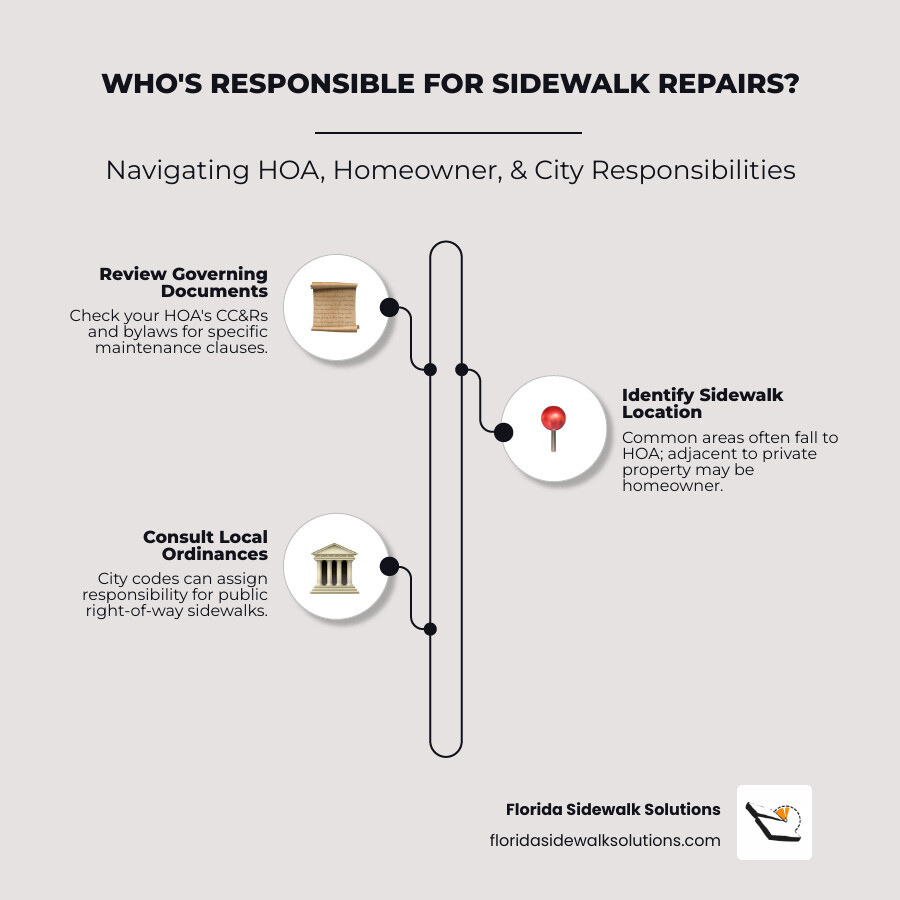
Deciphering the Responsibility Puzzle: HOA, Homeowner, or City?
Determining who manages and pays for HOA sidewalk repair is a major hurdle. The answer depends on your community’s governing documents, state laws, and local ordinances. Getting it wrong can lead to costly disputes, unrepaired trip hazards, and serious liability. Let’s break down the responsible parties.
The Role of Governing Documents
Your governing documents—the Covenants, Conditions, and Restrictions (CC&Rs) and bylaws—are legally binding contracts that define maintenance duties. The key distinction is “common areas” (HOA responsibility) versus “deeded property” (homeowner responsibility). Sidewalks can be tricky; a path to the pool is a common area, but the sidewalk in front of a house may be the homeowner’s duty. Read your documents carefully for specific language on sidewalks and exterior maintenance. If your documents are silent on the issue, state and local laws apply. The Florida Bar provides helpful guidance on HOA responsibilities when documents are unclear.
When the Homeowner is Responsible
Homeowners are often responsible for sidewalks adjacent to their private property, even if they seem public. Local ordinances in many Florida cities typically require property owners to maintain sidewalks along their property line, as shown by The City of Cincinnati’s sidewalk program. You could be liable for injuries if you knew about a hazard and failed to act. Driveway aprons are almost always the homeowner’s responsibility. Likewise, if roots from your trees damage the sidewalk, the repair is typically your duty. California’s sidewalk laws exemplify this principle, which is common in Florida municipalities.
When the HOA is Responsible
The HOA is responsible for common areas—shared spaces funded by HOA fees for everyone’s benefit. This includes walkways to pools or clubhouses, paths in shared green spaces, and sidewalks along private roads within the community. If a space is used by all residents and isn’t part of an individual lot, the HOA likely maintains it. Repairs are typically funded through reserve funds set aside for maintenance, which is a primary purpose of HOA fees.
The City’s Involvement
While many assume the city maintains all sidewalks in the public right-of-way, this is rarely true. Most cities require adjacent property owners to handle maintenance. However, cities typically repair damage caused by city-owned trees or their own utility work and may offer cost-sharing programs. Cities also enforce safety by issuing repair notices for hazards. If ignored, the city may perform the repair and bill the owner at a premium, as seen in cities like Minneapolis. Since municipal codes vary, contact your local public works department to clarify specific responsibilities in your area.
Why Sidewalk Safety is a Critical HOA Priority
A well-maintained sidewalk is a cornerstone of a safe, accessible, and valuable community. Neglecting repairs creates significant risks, from lawsuits to lower property values. Prioritizing sidewalk maintenance is a crucial investment in your HOA’s well-being and financial health.
Mitigating Legal & Financial Liability
Damaged sidewalks are classic trip hazards, and trip-and-fall accidents lead to severe legal and financial consequences. If someone is injured on a poorly maintained sidewalk, the responsible party (HOA or homeowner) can be held liable for negligence, especially if they knew about the hazard and failed to act. Lawsuits can be expensive, covering medical bills, lost wages, and legal fees. For an HOA, this can deplete reserve funds, raise insurance premiums, or force special assessments. A minor crack can quickly become a major legal and financial headache.
Ensuring ADA Compliance
HOAs must also comply with federal accessibility mandates. The Americans with Disabilities Act (ADA) requires sidewalks in common areas to be accessible. A key part of compliance is eliminating trip hazards, which the ADA defines as any vertical change of 1/4 of an inch or more at a joint or crack. Non-compliance can lead to Department of Justice fines and lawsuits. Ensuring smooth, accessible sidewalks fosters an inclusive community for all residents. Our specialized trip hazard removal services are designed to bring your sidewalks into ADA compliance efficiently.
Protecting Property Values and Curb Appeal
Beyond safety, well-maintained sidewalks significantly boost curb appeal and property values. Smooth, clean walkways signal a well-managed community, attracting potential buyers. In contrast, cracked or uneven sidewalks suggest neglect and can lower property values. Timely repairs also prevent minor issues from becoming large, expensive problems, saving money and preserving the community’s beauty and value long-term.
Identifying Trip Hazards: When Does a Crack Become a Liability?
Knowing how to spot a true sidewalk hazard is crucial for any HOA. While a hairline crack may be cosmetic, a raised slab is a serious liability. Proactive maintenance starts with identifying these issues. The ADA considers a vertical height difference of just 1/4 inch to be a trip hazard—a small measurement with huge safety and liability consequences.
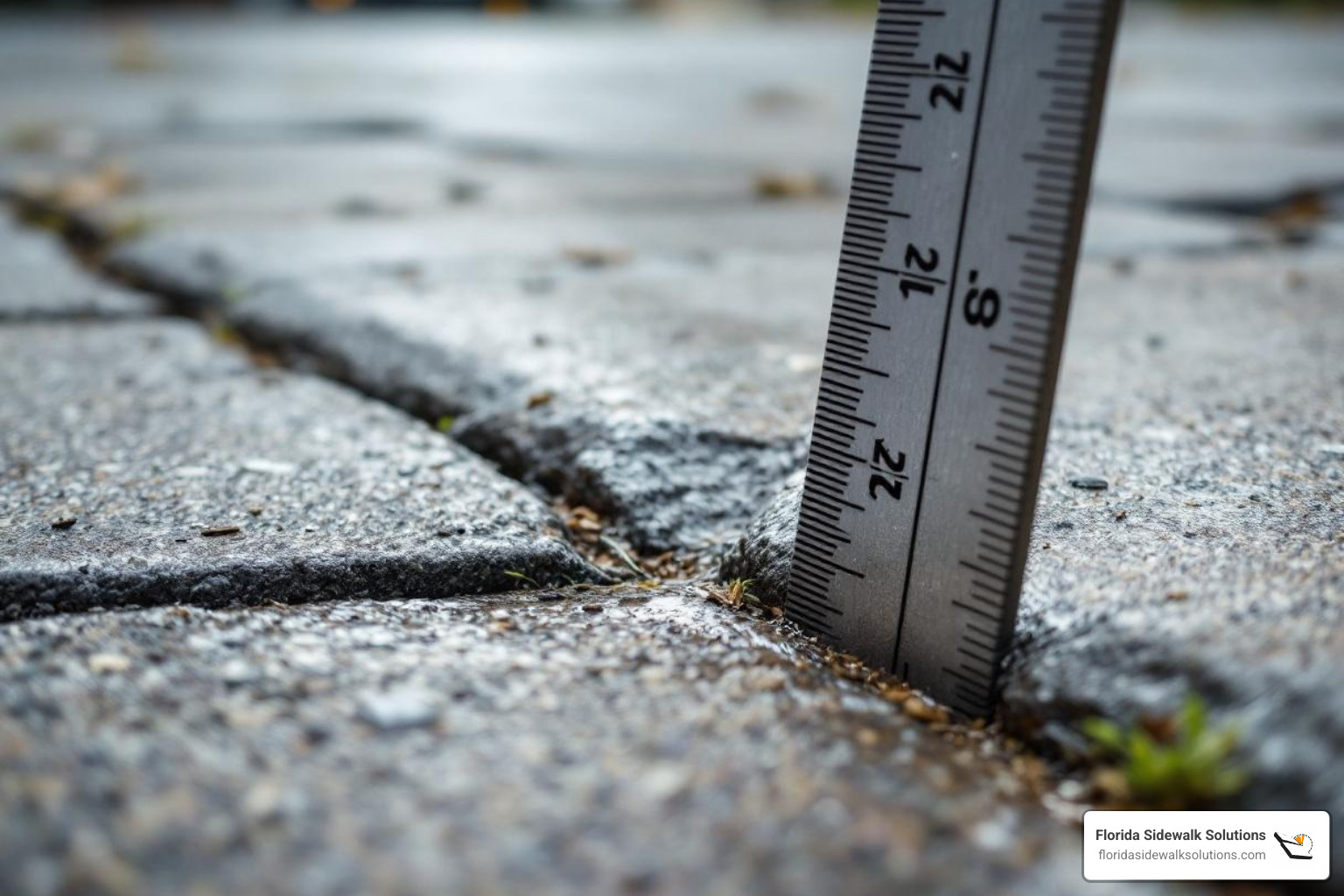
Common Signs of Unsafe Sidewalks
Regularly inspect sidewalks for anything that could cause a fall. Here are the most common signs a sidewalk needs attention:
- Uneven Slabs or Panels: A vertical height difference between concrete slabs caused by shifting or settling.
- Raised Edges: Often caused by tree roots pushing up the concrete, creating a lip that is easy to trip over. This is a common issue in Florida requiring HOA sidewalk repair.
- Sunken Sections: Depressions from soil erosion or poor compaction that can cause missteps and collect water, creating slip hazards.
- Wide Cracks: Gaps of 1/2 inch or more can catch a heel and may indicate deeper structural problems.
- Crumbling Concrete (Spalling): A flaking or pitted surface that creates a rough, unpredictable walking area with loose debris.
- Tree Root Uplift: A major cause of sidewalk damage in Florida, where powerful roots lift entire concrete sections.
- Water Pooling: Consistently collecting water indicates an uneven surface and drainage issues, creating a slip hazard and accelerating concrete decay.
- Discoloration: Can sometimes signal weakening concrete integrity.
Promptly addressing these signs is key to preventing injuries, ensuring ADA compliance, and protecting your community from liability.
The Smart Approach to HOA Sidewalk Repair
Once a trip hazard is identified, choosing the right repair method is crucial for a long-lasting, cost-effective, and compliant solution. Modern techniques offer superior results for the demands of ADA compliance and HOA sidewalk repair.
Comparing HOA Sidewalk Repair Methods
HOAs have several repair options, but they differ significantly in cost, disruption, and results.
- Traditional Grinding: While seemingly affordable for small bumps, grinding often leaves a rough, scarred appearance, can weaken the concrete, and lacks precision for guaranteed compliance.
- Full Removal and Replacement: This method is fully compliant but is also the most expensive, slow, and disruptive option. It involves excavation, long curing times, and creates significant waste, often resulting in a mismatched, patched look.
- Our Patented Concrete Cutting: This method for HOA sidewalk repair is a superior alternative. It is highly cost-effective (a fraction of replacement costs), fast with minimal disruption (sidewalks are ready for immediate use), and precisely engineered for ADA compliance. Our clean cuts create smooth transitions that preserve the slab’s durability and appearance with minimal waste.
Why Florida Sidewalk Solutions’ Concrete Cutting is the Superior Solution
We specialize in trip hazard removal using our patented concrete cutting technology—a game-changer for HOAs seeking effective, economical, and ADA-compliant solutions. Our method precisely removes trip hazards to meet the strict 1/4-inch ADA standard, creating a smooth, level surface. Unlike grinding, our process leaves a clean, aesthetic finish that doesn’t compromise the slab’s integrity.
Here’s why HOAs in Florida choose our method for their HOA sidewalk repair needs:
- Superior Precision: Our cutting technology ensures exact measurements, providing a perfectly smooth transition that eliminates trip hazards with unparalleled accuracy.
- Cost-Effective: Our method is significantly more economical than full removal and replacement, often costing just a fraction of traditional repair methods. This means your HOA budget goes further, allowing you to address more hazards and protect more residents.
- Less Disruptive & Faster: The repair process is quick, clean, and causes minimal disruption to your community. Sidewalks are typically ready for immediate use after our work is complete, avoiding lengthy closures.
- Long-Term Durability: By maintaining the structural integrity of the existing concrete slab, our repairs are durable and designed to last, preventing the rapid re-emergence of trip hazards.
- ADA Compliance Guaranteed: We specialize in bringing sidewalks into full ADA compliance, protecting your HOA from potential fines and liability related to accessibility issues.
Our commitment is to provide a superior solution that is more effective and less expensive than grinding or full replacement, distinguishing us with better technology and pricing.
A Proactive HOA Sidewalk Repair Strategy
A proactive HOA sidewalk repair plan is the best way to manage hazards. Consider these steps:
- Regular Inspections: Schedule and document routine sidewalk inspections to identify hazards early.
- Budgeting for Maintenance: Allocate funds for repairs in your HOA budget, ideally in a dedicated reserve fund, to avoid surprise expenses.
- Address Issues Early: Repair minor problems promptly to prevent them from becoming large, costly hazards.
- Tree Root Management: In Florida, this is crucial. Consult an arborist about root pruning or barriers to prevent sidewalk damage.
- Proactive Sealing: Apply concrete sealant every few years to protect against moisture and deterioration.
A proactive strategy helps HOAs maintain safe, compliant, and attractive sidewalks, protecting residents and the budget.
The High Cost of Inaction: Consequences of Neglecting Repairs
Ignoring a cracked sidewalk might seem like a way to delay an expense, but inaction can cost your HOA far more in the long run. Neglecting HOA sidewalk repair can lead to significant financial and legal consequences. Quick action is always the smartest and most cost-effective strategy.
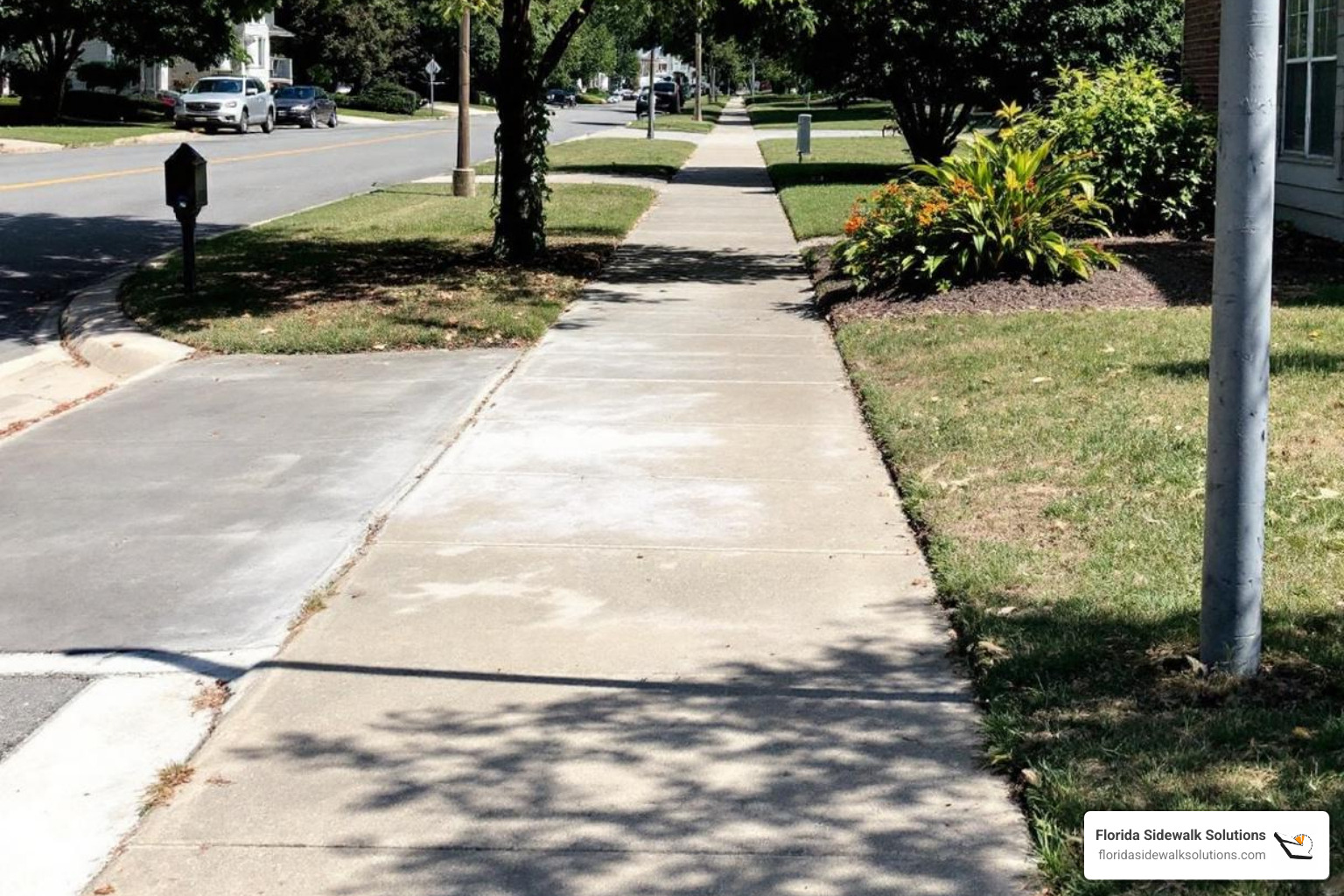
Forced Repairs and Liens
If an HOA or homeowner ignores a known trip hazard, Florida cities and counties can enforce repairs. You will likely receive a formal notice with a repair deadline. If you fail to act, the city may hire its own contractors, perform the work, and bill the responsible party at a premium. Unpaid bills can lead to a lien on the property, which prevents the sale or refinancing of the property until the debt is paid. This is a powerful tool municipalities use to ensure compliance, as detailed by cities like Minneapolis. These unexpected costs can even lead to special assessments for all residents.
Legal Action from Residents
The biggest risk of inaction is a lawsuit. If a resident or visitor is injured by a known trip hazard, the responsible property owner (HOA or homeowner) can be sued for negligence. These lawsuits are expensive, covering medical bills, lost wages, and more, potentially draining HOA reserves and increasing insurance premiums. Board members who knowingly ignore a hazard could also face personal liability for breach of fiduciary duty. A history of claims can make insurance coverage difficult to obtain or afford, with costs passed on to homeowners through higher fees. Proactive HOA sidewalk repair is a small investment that prevents catastrophic financial and legal consequences.
A Clear Path Forward for Your Community
Understanding HOA sidewalk repair responsibility is the first step to a safer community. As this guide has shown, clarity comes from reviewing your governing documents, knowing local ordinances, and committing to proactive maintenance.
You now know how to determine if the homeowner, HOA, or city is responsible, and why it’s critical to act. Sidewalk safety is about more than avoiding lawsuits; it’s about ensuring accessibility for all residents, meeting ADA standards (where a 1/4-inch lip is a hazard), and protecting property values.
You can also identify trip hazards like uneven slabs and tree root uplift before they cause an injury. The cost of inaction—forced repairs, property liens, and lawsuits—is far too high.
Fortunately, modern solutions make repairs easier than ever. Our patented concrete cutting method for HOA sidewalk repair is a smart alternative to disruptive replacement or messy grinding. It’s a fast, cost-effective, and precise way to create smooth, ADA-compliant sidewalks that last.
The path forward is clear: inspect regularly, understand your responsibilities, and address hazards promptly with an effective repair method. This proactive approach is an investment in your community’s safety, accessibility, and long-term value.
Your residents deserve a safe place to walk, and your HOA board deserves peace of mind.
Get a free estimate for your sidewalk repair needs today! Let’s work together to eliminate trip hazards and create the safe, welcoming community you envision. We’re here to help your HOA every step of the way.

